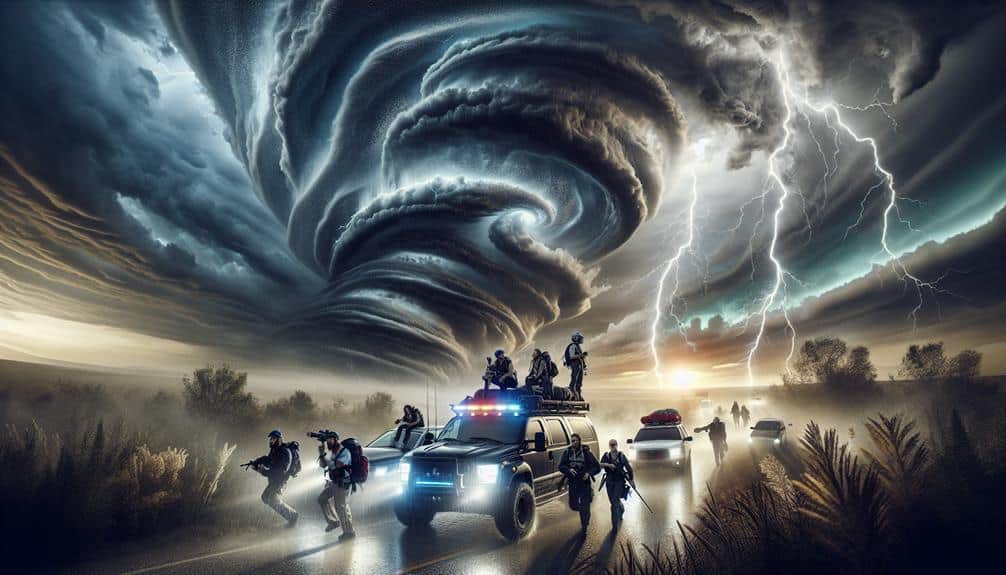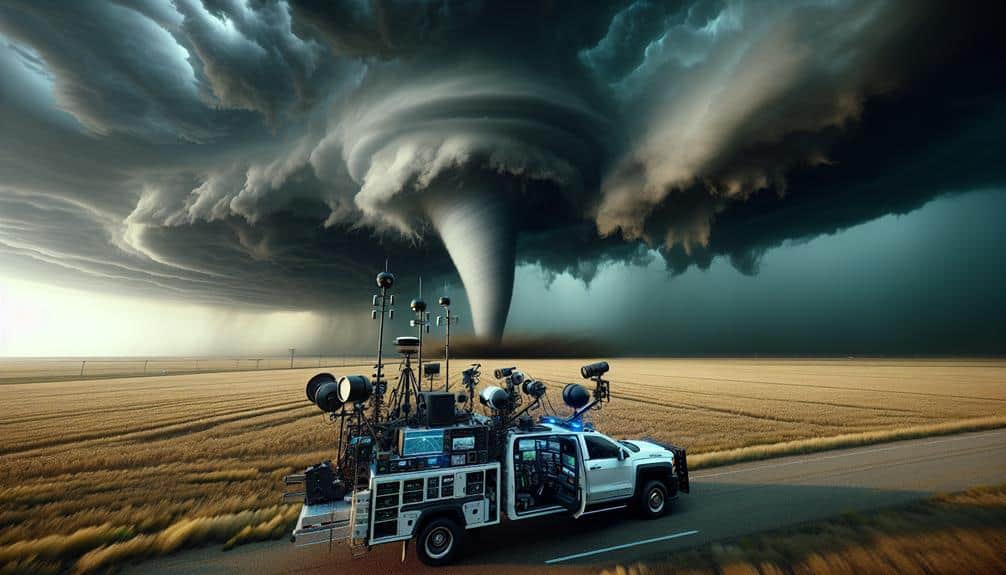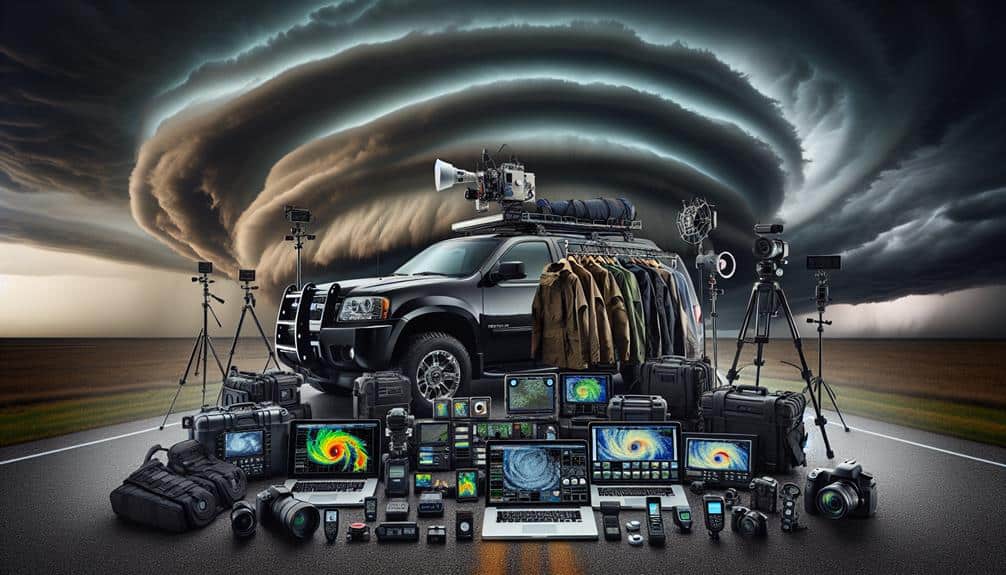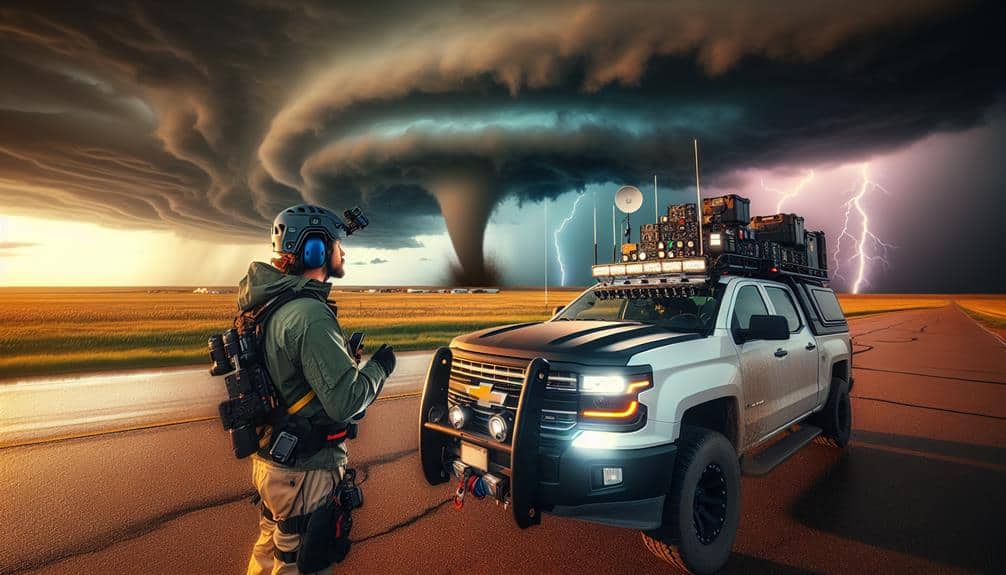As seasoned storm chasers, we must observe meticulous safety protocols to guarantee our missions are both successful and secure. First, we monitor weather updates from reliable sources like the National Weather Service and map out potential evacuation routes. Second, we use reliable equipment, keeping our vehicles and communication devices in top condition. Third, maintaining a safe distance from storm cores while utilizing advanced radar keeps us out of harm's way. Fourth, we plan multiple escape routes and shelter options. Lastly, traveling with a team enhances data accuracy and safety. These steps form the foundation of effective storm chasing operations.
Key Points
- Regularly monitor real-time weather updates and forecasts to stay informed about storm developments.
- Ensure all vehicles and equipment are well-maintained and equipped with necessary emergency supplies.
- Keep a safe distance from the storm core, using advanced radar and GPS systems for precise tracking.
- Plan and map out multiple escape routes and identify emergency shelters in advance.
Monitor Weather Updates
To ensure safety while storm chasing, we must consistently monitor real-time weather updates from reliable sources. It's pivotal to use advanced meteorological tools and trusted platforms like the National Weather Service or specialized storm-chasing apps. These updates give us the latest information on storm movements, severity, and potential risks.
We should also identify and plan for emergency shelters along our route. Knowing where to find these shelters can make a life-or-death difference during sudden weather escalations. Combining this knowledge with up-to-the-minute weather data allows us to react swiftly and effectively, ensuring we can seek refuge if conditions worsen unexpectedly.
Another vital aspect is mapping out evacuation routes in advance. We should familiarize ourselves with multiple escape paths, considering that some roads may become impassable due to flooding or debris. Real-time updates help us decide when to abandon our current position and which routes remain viable.
By integrating real-time weather monitoring with pre-planned evacuation routes, we maintain the flexibility to adapt to rapidly changing scenarios while maximizing our safety.
In essence, monitoring weather updates isn't just about gathering data; it's about transforming that data into actionable safety plans, ensuring our freedom to chase storms without unnecessary risks.
Use Reliable Equipment
Securing our safety while storm chasing necessitates the use of dependable equipment that can withstand extreme weather conditions. We need to prioritize equipment maintenance to guarantee our tools don't fail when we need them most.
Regularly inspect and service vehicles, ensuring tires, brakes, and engines are in prime condition. High-quality storm shelters should be part of our gear, providing a safe retreat if conditions worsen.
Communication devices are indispensable. Trustworthy two-way radios and satellite phones guarantee we stay connected, even when cell networks fail. GPS units with real-time tracking allow us to navigate accurately through unpredictable terrains. Each device should be tested frequently to ensure functionality during critical moments.
Emergency supplies are another essential component. Our kits should include first aid supplies, non-perishable food, water, and basic survival gear. A portable weather station can provide real-time data, helping us make informed decisions on the fly.
Investing in durable, waterproof cases for all equipment will protect against moisture and impact damage.
With a focus on dependable equipment, we not only enhance our safety but also ensure that the freedom of storm chasing remains an exhilarating and secure experience.
Maintain a Safe Distance
Maintaining a safe distance from the storm's core is important to mitigate the risk of sudden, severe weather changes. Our primary objective is to gather data without compromising safety. We must leverage advanced radar and GPS systems to monitor the storm's progression in real-time. These tools allow us to stay informed and make rapid adjustments to our position.
Hazard awareness is crucial. By understanding the storm's behavior, we can anticipate shifts in direction and intensity. This knowledge enables us to maintain a buffer zone, typically a minimum of several miles, depending on the storm type. For instance, supercells demand more distance due to unpredictable tornado formations.
Emergency protocols should be predefined and practiced. We need to establish communication lines, both within our team and with local authorities. Regular check-ins ensure everyone is accounted for and aware of the storm's latest developments. In case conditions deteriorate rapidly, these protocols facilitate swift, coordinated action.
Staying mobile and flexible is essential. Our vehicles must be in top condition, equipped with necessary supplies and reinforced to handle extreme weather. By maintaining a safe distance, we preserve our freedom to chase another day while ensuring our safety and the integrity of our mission.
Plan Escape Routes
Identifying multiple escape routes in advance is critical, as it allows us to swiftly navigate away from escalating danger zones during storm chases. Before we set out, we should meticulously study the geography and road networks of the area. By mapping out at least three potential escape routes, we make certain that we've alternatives should one become impassable due to debris or flooding. This proactive approach minimizes the risk of getting trapped.
Emergency communication is another essential element. We need reliable, redundant communication systems, including mobile phones, two-way radios, and satellite phones. These tools enable us to stay in constant contact with local authorities and other storm chasers, providing real-time updates on evolving storm conditions and road closures.
Shelter options should also be identified along our planned routes. Knowing the locations of sturdy buildings, such as schools, community centers, or other structures designed to withstand harsh weather, allows us to quickly find refuge if the storm's path shifts unexpectedly.
Additionally, monitoring weather forecasts and using GPS devices with live traffic updates can help us dynamically adjust our escape plans on the fly, maximizing our safety and freedom to chase storms without undue risk.
Travel With a Team

While having multiple escape routes is important for individual safety, traveling with a team further enhances our ability to navigate and respond to volatile storm conditions effectively. Team dynamics play a significant role in making sure that each member is aware of their responsibilities and can act swiftly during critical moments.
We divide tasks such as navigation, data collection, and weather monitoring, allowing us to cover more ground and make informed decisions faster.
Effective communication strategies are the backbone of any successful storm chasing team. We utilize a combination of radio communication, GPS tracking, and predefined hand signals to maintain constant contact, even when visibility is low or noise levels are high. Clear and concise communication helps us avoid misunderstandings and makes certain that everyone is on the same page, which is important when we're dealing with unpredictable weather patterns.
Moreover, traveling with a team provides additional safety nets. If a vehicle breaks down or someone gets injured, having multiple people on-site allows for immediate assistance and problem-solving. Our collective expertise also means we can cross-check each other's observations and predictions, reducing the likelihood of errors.
Essentially, a well-coordinated team maximizes both our operational efficiency and safety margins.
Frequently Asked Questions
What Should I Do if My Vehicle Gets Stuck During a Storm Chase?
When our vehicle gets stuck during a storm chase, we should first focus on vehicle extraction using emergency supplies. Communicate our location to others, and call roadside assistance. Remember, staying safe is our top priority.
How Do I Handle Encounters With Other Storm Chasers on the Road?
We must uphold road etiquette and adhere to safety protocols when encountering other storm chasers. Communicate intentions clearly, signal turns, and keep a safe distance to guarantee everyone's safety while pursuing our passion for storm chasing.
What Are the Best Apps for Real-Time Storm Tracking?
We can't beat around the bush; the top weather apps with safety features are RadarScope, Storm Shield, and Weather Underground. These best storm tracking apps provide real-time updates, ensuring we stay ahead of the storm safely.
Can I Storm Chase Without Prior Meteorological Knowledge?
We can storm chase without prior meteorological knowledge, but we must prioritize safety precautions and acquire necessary equipment. Utilizing GPS, weather radios, and emergency kits guarantees we're prepared for any situation, enhancing both safety and freedom.
How Do I Protect My Electronic Devices From Storm-Related Damage?
An ounce of prevention is worth a pound of cure. We protect our devices with waterproof cases and use surge protectors to shield against electrical spikes. These steps guarantee our gear survives the harshest storm conditions without fail.


